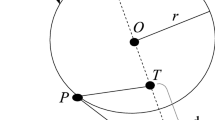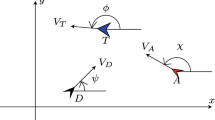Abstract
A novel pursuit-evasion differential game involving three agents is considered. An Attacker missile is pursuing a Target aircraft. The Target aircraft is aided by a Defender missile launched by, say, the wingman, to intercept the Attacker before it reaches the Target aircraft. Thus, a team is formed by the Target and the Defender which cooperate to maximize the separation between the Target aircraft and the point where the Attacker missile is intercepted by the Defender missile, while at the same time the Attacker tries to minimize said distance. A long-range Beyond Visual Range engagement which is in line with current CONcepts of OPeration is envisaged, and it is therefore assumed that the players have simple motion kinematics á la Isaacs. Also, the speed of the Attacker is equal to the speed of the Defender and the latter is interested in point capture. It is also assumed that at all time the Attacker is aware of the Defender’s position, i.e., it is a perfect information game. The analytic/closed-form solution of the target defense pursuit-evasion differential game delineates the state space region where the Attacker can reach the Target without being intercepted by the Defender, thus disposing of the Game of Kind. The target defense Game of Degree is played in the remaining state space. The analytic solution of the Game of Degree yields the agents’ optimal state feedback strategies, that is, the instantaneous heading angles for the Target and the Defender team to maximize the terminal separation between Target and Attacker at the instant of interception of the Attacker by the Defender, and also the instantaneous optimal heading for the Attacker to minimize said separation. Their calculation hinges on the real-time solution of a quartic equation. In this paper we contribute to the solution of a differential game with three states—an additional example to the, admittedly small, repertoire of pursuit-evasion differential games in 3-D which can be solved in closed form.


















Similar content being viewed by others
Notes
Here, we have used \(\tilde{x}\) to denote the state in the realistic plane. We reserve the use of x (without tilde) to denote the state in the reduced state space.
References
Bakolas E, Tsiotras P (2010) Optimal pursuit of moving targets using dynamic Voronoi diagrams. In: 49th IEEE conference on decision and control, pp 7431–7436
Barron EN, Jensen R (1986) The pontryagin maximum principle from dynamic programming and viscosity solutions to first-order partial differential equations. Trans. Am. Math. Soc. 298(2):635–641
Basar T, Olsder GJ (1999) Dynamic noncooperative game theory, vol 23. SIAM, Philadelphia
Boltyanskii V (1971) Mathematical methods of optimal control. Balskrishnan-Neustadt series. Holt, Rinehart and Winston, New York, p 268
Boyell RL (1976) Defending a moving target against missile or torpedo attack. IEEE Trans. Aerosp. Electron. Syst. AES–12(4):522–526
Boyell RL (1980) Counterweapon aiming for defence of a moving target. IEEE Trans. Aerosp. Electron. Syst. AES–16(3):402–408
Breakwell J, Hagedorn P (1979) Point capture of two evaders in succession. J. Optim. Theory Appl. 27(1):89–97
Earl MG, DAndrea R (2007) A decomposition approach to multi-vehicle cooperative control. Robot. Auton. Syst. 55(4):276–291
Fuchs ZE, Khargonekar PP, Evers J (2010) Cooperative defense within a single-pursuer, two-evader pursuit evasion differential game. In: 49th IEEE conference on decision and control, pp 3091–3097
Ganebny SA, Kumkov SS, Le Ménec S, Patsko VS (2012) Model problem in a line with two pursuers and one evader. Dyn. Games Appl. 2(2):228–257
Garcia E, Casbeer DW, Pachter M (2015) Cooperative strategies for optimal aircraft defense from an attacking missile. J Guid Control Dyn 38(8):1510–1520
Garcia E, Casbeer DW, Pachter M (2015) Escape regions of the active target defense differential game. In: ASME 2015 dynamic systems and control conference
Garcia E, Casbeer DW, Pachter M (2018) Optimal target capture strategies in the target-attacker-defender differential game. In: American control conference
Garcia E, Casbeer DW, Pham K, Pachter M (2014) Cooperative aircraft defense from an attacking missile. In: 53rd IEEE conference on decision and control, pp. 2926–2931
Garcia E, Casbeer DW, Pham K, Pachter M (2015) Cooperative aircraft defense from an attacking missile using proportional navigation. In: 2015 AIAA guidence, navigation, and control conference
Huang H, Zhang W, Ding J, Stipanovic DM, Tomlin CJ (2011) Guaranteed decentralized pursuit-evasion in the plane with multiple pursuers. In: 50th IEEE conference on decision and control and european control conference, pp. 4835–4840
Isaacs R (1965) Differential games. Wiley, New York
Lewin J (1994) Differential games: theory and methods for solving game problems with singular surfaces. Springer, London
Liu SY, Zhou Z, Tomlin C, Hedrick K (2013) Evasion as a team against a faster pursuer. In: IEEE american control conference (ACC) 2013, pp 5368–5373
Melikyan AA (1998) Generalized characteristics of first order PDEs. Birkhauser, Boston
Pachter M, Garcia E, Casbeer DW (2014) Active target defense differential game. In: 52nd annual allerton conference on communication, control, and computing, pp 46–53
Pachter M, Garcia E, Casbeer DW (2017) Differential game of guarding a target. AIAA J Guid Control Dyn 40(11):2991–2998
Perelman A, Shima T, Rusnak I (2011) Cooperative differential games strategies for active aircraft protection from a homing missile. J Guid Control Dyn 34(3):761–773
Pham K (2010) Risk-averse based paradigms for uncertainty forecast and management in differential games of persistent disruptions and denials. In: American control conference, pp 842–849
Pontryagin L, Boltyanskii V, Gamkrelidze R, Mishchenko E (1962) The mathematical theory of optimal processes, 1st edn. John Wiley & Sons Inc, Boca Raton
Prokopov O, Shima T (2013) Linear quadratic optimal cooperative strategies for active aircraft protection. J Guid Control Dyn 36(3):753–764
Ratnoo A, Shima T (2011) Line-of-sight interceptor guidance for defending an aircraft. J Guid Control Dyn 34(2):522–532
Ratnoo A, Shima T (2012) Guidance strategies against defended aerial targets. J Guid Control Dyn 35(4):1059–1068
Rubinsky S, Gutman S (2012) Three body guaranteed pursuit and evasion. In: AIAA guidance, navigation, and control conference, pp 1–24
Rubinsky S, Gutman S (2014) Three-player pursuit and evasion conflict. J Guid Control Dyn 37(1):98–110
Rusnak I (2005) The lady, the bandits, and the bodyguards–a two team dynamic game. In: Proceedings of the 16th world IFAC congress
Rusnak I, Weiss H, Hexner G (2011) Guidance laws in target-missile-defender scenario with an aggressive defender. In: Proceedings of the 18th IFAC world congress, pp 9349–9354
Scott W, Leonard NE (2013) Pursuit, herding and evasion: a three-agent model of caribou predation. In: American control conference, pp 2978–2983
Shaferman V, Shima T (2010) Cooperative multiple-model adaptive guidance for an aircraft defending missile. J Guid Control Dyn 33(6):1801–1813
Shima T (2011) Optimal cooperative pursuit and evasion strategies against a homing missile. J Guid Control Dyn 34(2):414–425
Siouris G (2004) Missile guidance and control systems. Springer, New York
Sprinkle J, Eklund JM, Kim HJ, Sastry S (2004) Encoding aerial pursuit/evasion games with fixed wing aircraft into a nonlinear model predictive tracking controller. In: 43rd IEEE conference on decision and control, pp 2609–2614
Yamasaki T, Balakrishnan SN (2010) Triangle intercept guidance for aerial defense. In: AIAA guidance, navigation, and control conference. American Institute of Aeronautics and Astronautics
Yamasaki T, Balakrishnan SN, Takano H (2013) Modified command to line-of-sight intercept guidance for aircraft defense. J Guid Control Dyn 36(3):898–902
Zarchan P (1997) Tactical and strategic missile guidance, vol 176. AIAA Progress in Aeronautics and Astronautics, Reston, VA
Acknowledgements
The authors would like to thank the anonymous reviewers and the Associate Editor for all their helpful comments. This is heartfelt: The paper was considerably improved during the review process thanks to the fruitful discussions.
Author information
Authors and Affiliations
Corresponding author
Electronic supplementary material
Below is the link to the electronic supplementary material.
Appendix
Appendix
Root locus analysis of the quartic equation
The problem parameter is \(0\le \alpha \le 1\). When \(\alpha =0\) the four roots of quartic equation (14) are: \(y=y_T\), \(y=y_T\), and \(y=\pm ix_A\), for all \(x_T\in \mathbb {R}^1\). When \(\alpha =1\) we have a quadratic equation whose roots are \(y=\frac{x_Ay_T}{x_A+x_T}\) and \(y=\frac{x_Ay_T}{x_A-x_T}\). If \(x_T=\pm x_A\), then one of the roots is given by \(y=+\infty \). This root takes a finite value as soon as \(\alpha \) decreases, that is, \(y<\infty \) for \(\alpha =1-\epsilon \) for some small \(\epsilon >0\).
When the discriminant of the quartic equation \({\varDelta }<0\), the quartic equation has two real roots and a pair of complex roots. We already know that Eq. (14) has two real roots, \(0<y<y_T\) and \(y>y_T\) as is indeed required by our theory for the case where \(x_T<0\) and \(x_T>0\), respectively. We will investigate quartic equation (14) using the continuation method, starting out from \(\alpha =0\) where we have a double real root \(y=y_T\)—we conduct a root locus investigation for \(0\le \alpha <1\).
To this end, differentiate quartic equation (14) in \(\alpha \)
Setting \(\alpha =0\) and \(y=y_T\), yields the relationship \(0\cdot \frac{\mathrm{d}y}{\mathrm{d}\alpha }=0\) and we cannot calculate \(\frac{\mathrm{d}y}{\mathrm{d}\alpha }\big |_{\alpha =0}\). Hence, differentiate Eq. (107) in \(\alpha \) again and set \(\alpha =0\)
Set \(y=y_T\) in Eq. (108)
Also, setting \(\alpha =0\) and \(y=\pm ix_A\) in Eq. (107) yields
Note that setting \(y=\pm ix_A\) in Eq. (108) yields
Root locus of quartic equation (14)
Let \(\frac{\mathrm{d}^2y}{\mathrm{d}\alpha ^2}=a+ib\). We calculate
Similarly,
So the two imaginary roots wander as a pair into the LHS of the complex plane, whereas the two real roots split off at \(y=y_T\) and move in opposite direction toward \(\frac{x_Ay_T}{x_A\pm x_T}\). The root locus picture of the roots of quartic equation (14) as a function of the problem parameter \(0\le \alpha <1\) is shown in Fig. 19. Importantly, our quartic Eq. (14) has two complex roots and two real roots \(y_1\ge y_T\) and \(y_2\le y_T\), as required by the theory of the ATDDG.
Rights and permissions
About this article
Cite this article
Pachter, M., Garcia, E. & Casbeer, D.W. Toward a Solution of the Active Target Defense Differential Game. Dyn Games Appl 9, 165–216 (2019). https://doi.org/10.1007/s13235-018-0250-1
Published:
Issue Date:
DOI: https://doi.org/10.1007/s13235-018-0250-1





